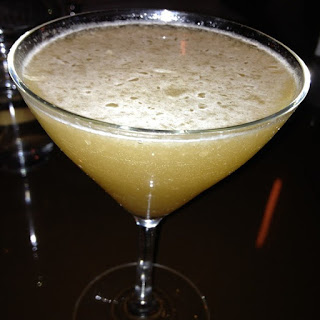The Sidecar
by Michael Frank
The Sidecar cocktail is by far one of most memorable cocktails to come out of American Prohibition. It brings to the table an elegant yet fruit-forward flavor profile that’s complemented by a naturally high acid content. While it goes best with a salty snack, it also makes a perfect aperitif or an aperitivo-- especially with large fatty, rich meals. With all the fruit juice that goes into it, some are deceived into expecting a sweet, easy-to-drink cocktail. Don’t let it fool you though; If you do try to gulp it down you’ll end up coughing. This is a concoction of complexity and power that is designed to be savored and enjoyed patiently.

The common belief is that the sidecar cocktail is named after those funny little attachments that people can put on the side of a motorcycle for a passenger. Another theory as to the origin of the name is that it’s named after a sidecar shot. A shot of sidecar is something you probably won’t see in any first world bars in our modern era. In short, a sidecar shot is when the bartender takes his barmat and dumps whatever liquid has accumulated into a shot glass. It saves on product cost and people love it. In my last bar we did this all the time and believe it or not, it actually doesn’t usually taste half bad.
The lore reads that it was invented by a wounded army field captain that rode between a bar and his encampment in a sidecar during the battles of World War I. Sounds like a tall tale to me, but hey-- good stories sell drinks.
The actual origin of the cocktail is traced back to the Ritz Carlton of Paris in 1922 and the American refugee bartender Harry MacElhone. Of course, this is a matter of some debate and some would attribute the original mixture to Robert Vermeire who published his book “Cocktails and How to Mix Them” the same year.
The original recipe calls for equal parts Congac, Triple Sec and Lemon Juice. I prefer a take on the more modern and popular version from Harry Craddock’s 1930 "Savoy Cocktail Book." My recipe for this cocktail follows that 1930s tradition while utilizing classic liquor selections and some “relatively” new mixology techniques. You will need the following:
The actual origin of the cocktail is traced back to the Ritz Carlton of Paris in 1922 and the American refugee bartender Harry MacElhone. Of course, this is a matter of some debate and some would attribute the original mixture to Robert Vermeire who published his book “Cocktails and How to Mix Them” the same year.
The original recipe calls for equal parts Congac, Triple Sec and Lemon Juice. I prefer a take on the more modern and popular version from Harry Craddock’s 1930 "Savoy Cocktail Book." My recipe for this cocktail follows that 1930s tradition while utilizing classic liquor selections and some “relatively” new mixology techniques. You will need the following:
For bar tools…
 Jigger 666444
Jigger 666444
Beehive Juicer 106266
18oz weighted shaker 644344
28oz weighted shaker 678987
Hawthorne strainer 643543
Martini glass 703622
For consumables…
Camus Borderies VSOP Cognac 102722
Cointrieu 106340
Lemons
Step 1
Start by adding 3 ounces of Cognac.
Cognac is really the star of this cocktail and despite all the heavy sugars and citrus we’re building on top of it, we really want that original essence to shine through in all its glory. For this I wouldn’t select anything too elegant or smooth. I’m not suggesting the use of poor quality brandy either though, what we want is something with just a little bit of spice and bite. For me, I like to use Camus Borderies VSOP because of the unique baking spice characteristics that come through on the nose and palate as well as its long and bold finish.
Feel free to swap out and have fun with and other brandy, as well, even if it’s not Cognac. One of the primary factors in the difference between a brandy and a Cognac is that Cognac comes from Cognac, France, and has its own AOC (Appellation d'origine contrôlee, the French certification granted to certain French geographical indications for wines, spirits, cheeses, butters and other agricultural products). Even if someone somewhere else were to make the same spirit with the same grapes in let’s say Bordeaux, it could only be called brandy. One of my favorite substitutions is Spanish brandy such as Torres 10.
Step 2
Add 1 ounce of Cointreau.
I like to use Cointreau because it’s the most orange-y of all the orange liqueurs, also it's not overly sweet. You can use triple sec too, if you like, but keep in mind it will make things sweeter.
Step 3
Squeeze 1 ounce of fresh lemon juice into your jigger. Don’t do this over the shaker as it will make it hard to keep things accurate. When your jigger is full, dump the fresh squeezed lemon juice into your shaking tin.
Step 4
Fill your other shaker with ice, put the two together and shake the heck out of it! Make sure you hold both cups securely, we want this cocktail “in” you and your guests, not “on” you. When shaking, shake back and forth between the two bottoms of the cups to give it the best chance of marrying the ingredients. Do this for about 30 seconds. Don’t be shy, give it all you’ve got!
Step 5
Get your martini glass ready. Tap the two conjoined metal cups gently on the edge of your bar (or anywhere else) to break the vacuum seal you created. Take your hawthorn strainer, place it over the cup and carefully pour everything into your glass.
Step 6
Enjoy! Another technique you might want to try out would be putting it through a netted strainer on it’s way into the glass, this will give it a whole new mouthfeel. Also, feel free to swap out the base liquor. I made one recently with a heavily peated Scotch and it was great. Another option is to use different citrus: kumquats, maybe? Most importantly, have fun and experiment. The worst case scenario is that you’ll have to make another drink.
May your cocktail adventures be glorious!Sidecar photo: foodspotting.com


